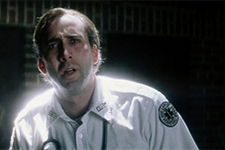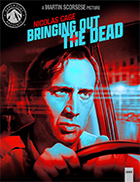Bringing Out the Dead (4K UHD)
|  Bringing Out the Dead, the harrowing, darkly comic tale of a graveyard-shift ambulance paramedic who feels that, rather than playing the angel of mercy, he is trapped playing the angel of death, was the fourth collaboration between director Martin Scorsese and screenwriter Paul Schrader. As with their previous films—Taxi Driver (1976), Raging Bull (1980), and The Last Temptation of Christ (1988)—Bringing Out the Dead is an introspective, deeply spiritual film about a character who is trying to find redemption. It has, at its core, a hunger to understand what redemption means in a violent, unstable world. One of the first things we learn about the protagonist, Frank Pierce (Nicolas Cage), is that he hasn’t saved a victim in months. “After a while, I grew to understand that my life was less about saving lives than about bearing witness,” he tells us in a somber, sometimes labored voice-over narration that probably could have been jettisoned without much loss. One look at Frank’s distraught, hollow eyes tells us that he is burned out, on the edge, and that it wouldn’t take much to push him over. We follow him over three nights, during which he hits the bottom and searches for some kind of redemption. In many ways, Bringing Out the Dead is an obvious companion piece to Taxi Driver: Both films are about lost men who prowl the streets of New York at night, coming into contact with the desperate, sometimes pathetic, and often dangerous products of urban desolation, and aching for meaning. And, ironically enough, both Travis Bickle and Frank Pierce eventually find their salvation by purposefully becoming an angel of death, although Frank goes about it in a drastically different manner. The tone of Bringing Out the Dead is wildly uneven, ranging from outright comedy, to horrifying desolation. Some scenes and many of the characters are absolutely hilarious, including a stern hospital security guard constantly threatens, “Don’t make me take off my sunglasses” (spoiler alert: he never does). Other scenes are gut-wrenching in their naturalistic horror, including one in which Frank and his partner help a homeless woman give birth to twins in a dilapidated high-rise, and Frank is left holding a stillborn in his hands. And then there are the ghosts. They stand on dark street corners and stare at Frank in his ambulance with glassy, accusing stares that ask, “Why couldn’t you save me?” Frank is especially haunted by the specter of an 18-year-old homeless girl who died under his care six months earlier. Frank sees her everywhere, and in one of the most memorable scenes, every person standing on a street corner takes on her face. Few directors could manage such a balancing act of comedy and horror, but Scorsese pulls it off with raucous aplomb. There are times when it feels like he is pushing things too far, giving the film the kind of wild, manic energy that suffused his dark, nocturnal comedy After Hours (1985); but, just when he is about to go over the edge, he pulls back. He and cinematographer Robert Richardson, who had shot all of Oliver Stone’s films, from Salvador (1986) to JFK (1991), use wildly canted camera angles, contrast neon lights with perpetual darkness, and speed up and slow down the imagery (you can feel Stone’s adrenaline-addled influence throughout). The film also employs a thumping soundtrack that mixes pop music from R.E.M., UB40, Jane’s Addiction, and the Clash that intensifies its brutal portrait of the medical world serving Hell’s Kitchen in the early 1990s. Dirty, overcrowded hospitals that have to refuse patients are the norm. Instead of pristine, white hospital corridors suggesting health and sanitation, the walls are covered with grungy green tiles that visually evoke sickness and gangrene. Doctors and nurses who were probably once idealistic are now cynical and aggravated, exhausted of their patience and empathy. We regularly see the head nurse (Mary Beth Hurt) counseling drug addicts and alcoholics: “Why should we help you?” she asks a weeping crackhead. “Did we stuff the cocaine up your nose?” Schrader’s script, which was based on the critically acclaimed, semi-autobiographical first novel by Joe Connelly, mixes a tableau of eccentric characters (apparently, the novel had even more, but Schrader wisely streamlined them). Over the course of the film, Frank has three partners. First, the angry and obese Larry (John Goodman); then, the flamboyant evangelical Marcus (Ving Rhames); and, finally, the psychotic Tom (Tom Sizemore). All of these characters are vastly different, but each of them possesses his own brand of energy and drive that Frank is lacking. Seeing him next to any one of them demonstrates just how burnt out he is. Frank also develops a relationship with Mary Burke (PatriciaArquette), a young woman whose father has had a heart attack and is slowly wasting away in a vegetative state. Although their scenes together are the weakest part of the film, Mary still has an important role to play in the arc of Frank’s redemption because he sees in her the possibilities of hope and renewal. Of course, Frank is trapped in his own haunted despair, but, as the film makes clear, there is always redemption (as dark and grisly as it can be at times, it is also suffused with hope, which is what differentiates it from Taxi Driver). Frank finds redemption in strange places, including the Oasis, a drug lair run by a smooth-talking dealer named Cy (Cliff Curtis). But, if Frank’s salvation is not exactly traditional, neither is the film. Part comedy, part drama, part existential horror film, Bringing Out the Dead has all the marks of an artist deeply committed to his vision.
Copyright © 2024 James Kendrick Thoughts? E-mail James Kendrick All images copyright © Paramount Home Entertainment | |||||||||||||||||||||||||||||
Overall Rating: 


 (3.5)
(3.5)


